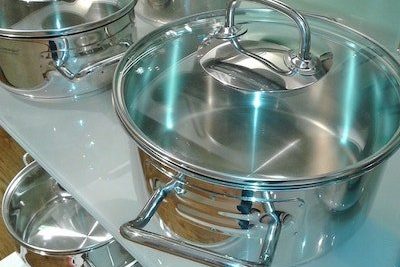Does Sous Vide Kill Bacteria?
One of the main questions people have about sous vide cooking is whether it’s a safe way to prepare food.
The long, low-cooking times and reduced oxygen environment of immersion cooking may run counter to many of the things we have traditionally learned about in food safety.
So, it’s essential to understand food safety and know if it’s true that sous vide does kill bacteria.
Foodborne Bacteria and Illnesses
There is a wide range of bacteria that live naturally in and on our food. Washing, cooking, and proper food storage help to prevent these bacteria from making us sick. Here are some of the most common illness-causing bacteria in food.
Norovirus
Norovirus is found in foods that have been contaminated with fecal matter and are most commonly found in shellfish and salad vegetables. It is the most common cause of gastroenteritis.
Salmonella
Salmonella can be found in a vast range of foods, including meat, eggs, fruits, vegetables, and sometimes even prepared and processed foods like frozen foods and nut butters. It can cause a wide range of illnesses, including typhoid fever.
Clostridium perfringens
Clostridium perfringens is naturally occurring in soil, sediment, and decaying vegetation. It is found most often in beef, poultry, gravies, and is the most common cause of food poisoning in the US.
Campylobacter
Campylobacter is most frequently found in poultry, unpasteurized milk, and occasionally in contaminated produce. It is the most common cause of gastroenteritis in Europe.
Staphylococcus aureus
Staphylococcus aureus is most frequently associated with skin infections, but it can also cause food poisoning through meat, poultry, eggs, dairy, and other tainted foods.
Clostridium botulinum
Clostridium botulinum causes botulism and is most frequently found in preserved vegetables, preserved fish, and preserved meat products.
Listeria
Listeria is a common foodborne pathogen, often found in unpasteurized dairy products, raw fruits and vegetables, and ready-to-eat meat and seafood products.
Escherichia coli
E. coli is found in contaminated foods, often in raw or undercooked meat, vegetables, and unpasteurized milk.
Vibrio
Vibrio are bacteria typically found in saltwater and can cause illness when eating undercooked seafood.
As you can see, there is no type of food that is free of pathogens, and they can be found in any ingredient you may be cooking with.
Read also: Is Sous Vide Cooking Healthy?
What Temperature Do You Cook Food to Kill Bacteria?
To kill bacteria, you need to cook foods to a safe internal temperature. The FDA has created food safety guidelines you can review here.
Broadly speaking, fresh meats, fish, and shellfish should be cooked to an internal temperature of 145°F (62.8°C); eggs and ground meat should be cooked to 160°F (71.1°C); poultry and leftovers should be heated to 165°F (73.9°C).
It’s also important to wash produce thoroughly and store food properly after cooking.

Does Sous Vide Kill Bacteria?
Sous vide not only kills bacteria, but it’s a great way to make sure that you are cooking food safely.
The anaerobic (which means without air, or in other words, oxygen) cooking environment and long cooking times of sous vide may create good conditions for bacterial growth. However, the precision of setting the cooking temperature and the even internal heating of sous vide ensure that you reach optimal internal temperatures to make your food safe.
Here are some more specific guidelines for how to kill bacteria when sous vide cooking.
Reach the Correct Internal Temperature
To kill bacteria and make food safe, the core measure is the food’s internal temperature, not the temperature of the water bath.
With traditional cooking, you might use a meat thermometer to check the internal temperature of food.
However, if you are cooking sous vide in vacuum-sealed bags, that isn’t as easy. Here are some tips for killing bacteria with sous vide:
- Check the temperature accuracy of your immersion circulator. Some are more accurate than others, and it’s common for thermometers to become less accurate over time. It’s a good idea to invest in a high-quality food thermometer and check your sous vide temperature settings’ accuracy periodically.
- Cook foods at the right temperature long enough. For most meats, a 1-inch-thick cut needs to cook for an hour, while a 2-inch-thick cut needs four hours to reach the correct internal temperature. However, sous vide cooking makes it impossible to over-cook foods, so follow the recipe and allow enough time to reach the right internal temperature.
Pre-sear Steaks and Other Rare Meats
Some people prefer steaks with a low internal temperature because they like them rare. However, that low temperature (usually 130°F [54.4°C]) may not be high enough to kill bacteria.
For rare meats, you can sear and brown the exterior first, which kills any surface bacteria, then sous vide the steak to the internal temperature you want.
Pasteurize With Sous Vide
You can use sous vide or an immersion cooker to pasteurize your food, kill bacteria, and extend your food’s storage life.
To pasteurize food, it simply needs to be brought to the correct internal temperature to kill bacteria, but not high enough to cook the food. It can then be safely stored for final cooking and serving at another time.
For example, heating eggs to 135°F (57.2°C) for two hours kills bacteria without cooking the eggs. They can then be safely stored in the refrigerator for a longer time. To pasteurize foods with sous vide, research time and temperature guidelines for your specific food.
In Summary
Sous vide cooking is a great way to kill bacteria and ensure your food is safe while preserving flavor, tenderness, and natural juices.
We already know the necessary temperatures to kill foodborne bacteria, and immersion cooking allows incredible temperature precision while preventing overcooking. You can simply set-it-and-forget-it.
When in doubt, double-check the FDA guidelines, and keep a second thermometer for periodic accuracy checks. Sous vide foods are not only as safe or safer than other cooking methods, but you can kill bacteria without over- or-undercooking foods, making them even more delicious.








